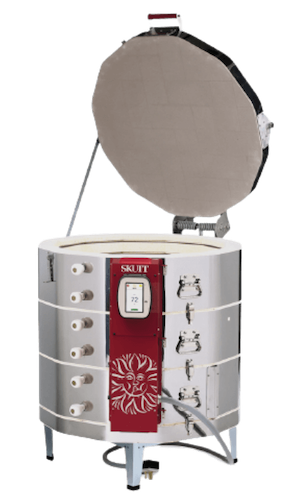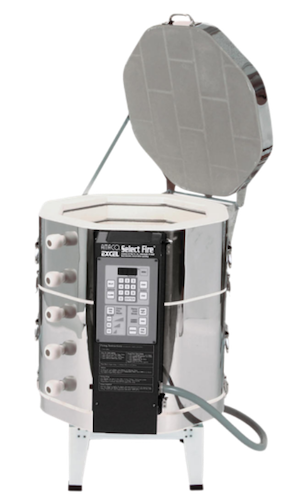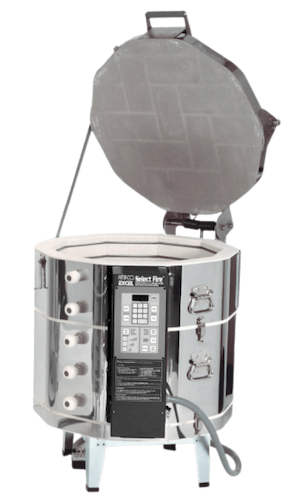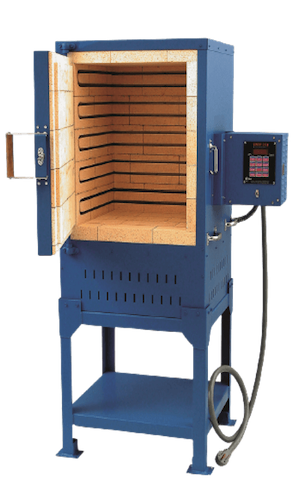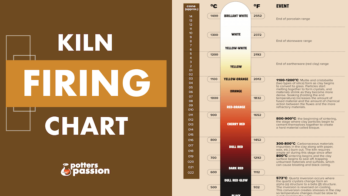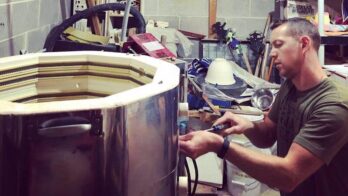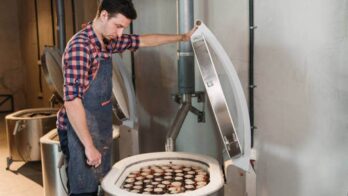Are you ready to take your love of pottery to the next level? If you’re thinking about starting a home studio, deciding on which Kiln to purchase is an important first step.
There are many different types of kilns available on the market, and determining which one will be the best fit for your long-term needs is not always as straightforward as it would seem.
Pottery kilns are a significant financial expense that requires careful consideration. There are other safety concerns to consider when purchasing a ceramic kiln for home use. In this buyer’s guide, we’ll go over all you need to know about buying the best pottery kiln for your needs.
Choosing the Best Kiln for Home Use
Choosing and buying a ceramic kiln can be a difficult undertaking; yet, the adage “you get what you pay for” could not be more true when it comes to purchasing a kiln. One brand is not necessarily comparable to another.
It is important to conduct thorough research before making what is likely to be the most important pottery purchase you will ever make. Here are the important factors that you need to consider.
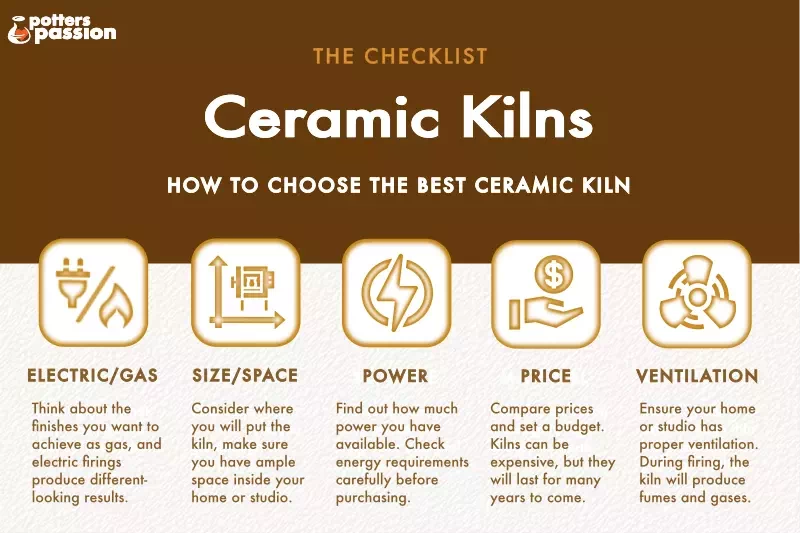

Electric or Gas
Electric kilns are significantly easier to fire than gas kilns, and they are frequently favored for bisque firings. They are also more common in homes due to the difficulty in obtaining permits to use gas kilns.
Electric kilns generally produce brighter colors, while gas kilns produce more earthy, muted hues because of their oxidation environment (the lack of oxygen in the air caused by the fire burning the oxygen away).
All gas kilns can be used with either natural gas or propane. The vast majority of kilns sold are electric, and this is what we recommend for home use.
Size, Capacity & Workspace
Keep in mind that the kiln’s overall dimensions are far more than the size of its internal firing chamber. Ceramic kilns are constructed with thick walls of insulation to keep in the heat.
So, make certain that you have adequate space at home. To avoid any potential fire risks, you should leave some open areas around the kiln.
What Size Kiln Do I Need?



- Up to 9″ x 11″ – It is perfect for firing beads and smaller items, as well as serving as a test kiln.
- 18″ x 18″ – Perfect for a part-time potter who works on the weekends but doesn’t make many pieces or makes small ones.
- 23″ x 27″ – This is the most popular size sold and is suitable for the average potter.
- 29″ x 27″ – Good for large-scale production.
From this list, you can determine which size is the most appropriate, keep the following in mind: What kind of products do you make? Small, Large? You’ll typically want to fire an entire kiln load to achieve maximum efficiency.
Power Requirements
Single-phase electricity is accessible in the majority of homes at 120v and 240v. Only smaller kilns can operate on 120v (normal household voltage). There simply isn’t enough power to heat a large kiln.
So, should you buy a 208v, 240v, single phase or three-phase kiln? What voltage should you use? Unfortunately, this is not a choice you can make; rather, it is decided by the amount of power you have.
You’ll need to purchase a circuit breaker that can handle the amperage requirements of the kiln you’ve chosen. You may need to call an electrician to come out and complete a small amount of wiring, which is especially important for larger kilns.
Price
The size of the kiln is the most important factor in determining its cost. When it comes to staying within a budget, purchasing a smaller model is an excellent choice. However, if you choose a larger one, you may have more choices in the future if you decide to boost your production.
How Much Is A Kiln For Pottery?


Expect to pay roughly $1000 for a kiln that is on the lower end of the price range. In contrast, one of the most expensive kilns will cost you more than $5000.
Kiln Ventilation
If you have an electric ceramic kiln in your home, you will almost certainly require a kiln vent. Some gases are produced, particularly during the bisque firing, that you must avoid breathing.
An exhaust vent is still recommended, regardless of whether or not your kiln is located in your garage or an outbuilding, because the additional oxygen they supply results in a healthier, cleaner bisque fire and some brighter glaze colors. They also aid in the removal of all of the moisture that is expelled from the clay.
The Best Ceramic Kilns – Our Top Picks
There are many different types of pottery and ceramic kilns to choose from. Even with all of the information provided above, choosing the most suitable one will not be simple. Whether you’re a beginner or an experienced professional, you’ll find something on our list that suits your needs and budget.
1. Skutt Kilnmaster Touchscreen KMT-818
The Skutt KMT 818 comes with the latest technology, a touchscreen control panel, the ability to download free software, and you can also control it from your phone. It has a cone fire mode for bisque or fire glazing and ramp mode, and you can input your own programs. At 17″ x 17″ x 18″, it’s compact and sleek enough for any small professional workshop.
- 18-inch diameter, 18-inches deep (2.6 cubic foot) firing chamber capacity.
- Has presets for small Professional or Home Studios.
- Download software updates for free.
- Comes with built-in Wifi and can be controlled from your phone.
- Has a touchscreen control panel.
- 120v 15 amp home outlet.
With its current sensor technology, it’s easy to read the voltage and under load. It runs on a single-phase 208-volt current. Its preset programs are ideal for classrooms and experts of smaller pieces.
Skutt Kilnmaster KMT-818 Specs
*Note that height measurement includes stand.
| Voltage | 208 or 240 Volts |
| Maximum Temperature | 2350ºF, 1288ºC—Cone 10 |
| Chamber Depth | 18″ |
| Chamber Capacity | 2.6 cubic feet |
| Exterior Dimensions | 22.5″ W x 22.5″ D x 32″ H |
| Shipping Weight | 160 lbs |
The Skutt KMT 818 is a great choice of kiln for anyone who also loves technology. With its unrivaled latest technology touchscreen control panel, setting your kiln couldn’t be easier. If you have to nip to the store or you’re in bed, that’s alright too, as you can check the status of your kiln from your phone.
It is so compact and sleek that it can fit into small spaces. It reaches temperatures of 2250F. Being able to download free updates means you’ll have the very latest choices available.
2. Skutt Kilnmaster Touchscreen KMT-1227
The Skutt 1227-3 comes with automatic touchscreen controls. It also comes with a free app that allows you to monitor the status of the Kiln if you have to pop out. Almost every page has a help option, making it easy for beginners as they are guided through every step of programming in full sentences.
- 28-inch diameter, 27-inches deep (9.9 cubic foot) firing chamber capacity.
- Ideal for larger home studios.
- Downloadable updates for ultimate performance.
- KMT touchscreen controller with built-in WiFi.
- Live diagnostics help straight from Skutt.
- Suitable for a large production rate.
This ceramic kiln is rated cone 10 @ 240 volts, and cone 5 @ 208 volts. Built-in wifi allows free upgrades; therefore, your Kiln will always work at optimal performance. The controller is hinged, and you can push it up and down to lift it to face you; then, when you’ve finished setting it up, push it back down. It also has a backlight which means you can read it from across the room.
Skutt Kilnmaster KMT-1227 Specs
*Note that height measurement includes stand.
| Voltage | 208 or 240 Volts |
| Maximum Temperature | 2350ºF, 1288ºC—Cone 10 |
| Chamber Depth | 27″ |
| Chamber Capacity | 9.9 cubic feet |
| Exterior Dimensions | 34″ W x 34″ D x 41″ H |
| Shipping Weight | 400 lbs |
A cone fire mode makes programming easy, and it’s based on the cone value. It also stores the last ten firings, so you don’t have to reset it again. You can choose to use one of the stored firing settings. If you should run into any problems, you can contact Skutt online, and they will help you with diagnostics as can view your data.
This kiln is like a dream. It’s so simple to set up, easy to program and has all the same functions you have come to know plus more. With all the latest technology of automatic touchscreen, the free apps, wifi, and direct online help with diagnostics, it’s no wonder this high quality kiln is rated as a top favorite.
This is a good choice for larger studios, from its step-by-step program to its ten cubic square feet of loading space.
3. Amaco Excel Kilns with Select Fire
The Amaco Excel is a 22″ deep, single-phase Kiln and can fire pieces up to 18″ tall. Designed to make loading easier, they have a modular design and stainless steel construction. Their ten cone capability makes it flexible for low-fire and high-fire pieces, and the modular design is great if you need to replace one of the high-quality Kanthal A-1 elements or a brick.
Amaco Excel EX-329-SF
- 16 1/2-inch diameter, 22-inches deep (2.9 cubic foot) firing chamber capacity.
- Select Fire™ Computer Control for easy operation.
- Offers flexibility with low or high firing.
- Fires pieces up to 18″ tall.
- High-Quality Kantha A-1 Coil Elements.
- Can achieve maximum temperatures of 2345 F (1285 C) or Cone 10.
More features of this Kiln are the reversible slabs and not forgetting the E-Z lift spring-assisted lid, corrosion-resistant lug connectors, and the steel stand with no-mar rubber feet. It comes with a 7ft long power cord and can be disassembled easily to get through narrow spaces.
Amaco Excel EX-329-SF Specs
*Note that height measurement includes stand.
| Voltage | 208 or 240 Volts |
| Maximum Temperature | 2381ºF, 1305ºC—Cone 10 |
| Chamber Depth | 22″ |
| Chamber Capacity | 2.9 cubic feet |
| Exterior Dimensions | 29″ W x 22.5″ D x 36″ H |
| Shipping Weight | 180 lbs |
The AMACO EX-329-SF has a firing area of 2.9 cubic feet. If you feel this isn’t sufficient for your needs, then perhaps the AMACO EX-353-SF would, with its pretty large 5.25 cubic feet firing chamber.
Amaco Excel EX-353-SF
- 22 1/2-inch diameter, 22-inches deep (5.25 cubic foot) firing chamber capacity.
- High-quality 3-inch firebrick construction.
- Sturdy design with E-Z lift lid for heavy-duty use.
- Excellent for students or people short in stature.
- Reversible lid and bottom slabs that extends the life of the kiln.
- Can achieve maximum temperatures of 2345 F (1285 C) or Cone 10.
Whichever AMACO EXCEL kilns you choose, you can rest assured they are well built and made to last. Designed with easy loading in mind and at 22″ deep, they are 4″ deeper than other models.
Amaco Excel EX-353-SF Specs
*Note that height measurement includes stand.
| Voltage | 208 or 240 Volts |
| Maximum Temperature | 2381º F, 1305º C—Cone 10 |
| Chamber Depth | 18″ |
| Chamber Capacity | 5.25 cubic feet |
| Exterior Dimensions | 35″ W x 28.5″ D x 36″ H |
| Shipping Weight | 320 lbs |
They are ideal for younger students or people who are short in stature. Being able to fire up to 18″ tall pieces is just another bonus, and the flexibility of the low-fire or high-fire pieces option is great. Its modular design makes it simple to replace an element or brick.
4. Paragon Iguana Digital Front-Loading Kiln
The Paragon Iguana is loaded with features. It has a standard 6-50R outlet and reaches a maximum temperature of 2350 Fahrenheit. It comes with a 2.0 sentry controller (which is unsurpassed in quality and reliability within its price range) and has a switch to shut the controller off when not in use.
- Easy to load, with a 22″ stand that raises the interior floor height of the kiln to 34½” high
- Saves electric with 3″ firebricks.
- Spacious enough for tall and bulky pieces.
- Spring-loaded latch door with recessed firebrick lip that seals in heat.
- Reaches temperatures of 2350 Fahrenheit or Cone 10.
- 2 Peep holes to check inside without losing heat.
The Paragon Iguana is just loaded with safety features. There are two peepholes to look inside without losing any heat. The Iguana fires to cone ten and has a pre-programmed cooldown. It saves on electricity by having 3″ fire bricks and is fitted with heavy-duty elements, which won’t burn out as they are made to handle the intense heat. The door swings wide open and is safely held on by a ½ inch steel rod.
The Paragon Iguana Specs
*Note that height measurement includes stand.
| Voltage | 208 or 240 Volts |
| Maximum Temperature | 2350ºF, 1288ºC—Cone 10 |
| Chamber Depth | 18″ |
| Chamber Capacity | 4.20 cubic feet |
| Exterior Dimensions | 36″ W x 31.30″ D x 60″ H |
| Weight | 530 lbs |
The Paragon Iguana is for the serious home ceramic crafter, this premium kiln would work well in a studio, and it’s small enough to fit in any corner. It is ideal for anyone who struggles with top-loading kilns, especially with their tall and bulky pieces. Also, the shut-off switch to the controller gives real peace of mind.
The heavy-duty elements are another plus as you don’t need to worry about them burning out. This kiln fires to cone ten and reaches temperatures of 2350 Fahrenheit. Its digital sentry controller makes it easy to program it as you wish. This Kiln has a standard 6-50 R outlet, so it’s ready to run if you’re already wired for kilns.
Buying Guide: Key Features to Consider in a Ceramic Kiln
A lot of factors need to be considered when purchasing a kiln. These include the types of items you intend to make as well as the environment in which you will be operating the kiln. The following are some of the aspects to consider:
Type of Clay and Glaze
You must be clear about what you intend to produce before purchasing a ceramic kiln. Clays and glazes all develop at different temperatures, so you must be clear about what you intend to make before purchasing a kiln. Because the temperature requirements for working with glass, porcelain, stoneware, and earthenware are different, you must match the kiln’s capabilities to those requirements.
If the clay is fired at a too high temperature, it can be completely destroyed (it can distort the clay and, in extreme situations, even melt it), and the glaze can begin to run off. It is possible to wind up with a dry, coarse finish if the temperature is too low.
Similarly, the temperature at which glazes should be fired varies substantially depending on the type of glaze. Some, such as Raku, require a low-temperature range, but others (such as Oxide stains) require a higher temperature range.
Top vs. Front Loading Kilns
When picking between a top-loading and a front-loading kiln, it’s crucial to consider your height and lower back. Top-loading kilns are less expensive, but they might be challenging to deal with if you don’t have a lot of height on your side.
Constantly leaning forward and bending puts a lot of strain on your lower back. You will ultimately have to decide whether the added convenience and health benefits of loading and unloading from the front of a kiln are worth the additional cost.
Temperature
Not all ceramic kilns can attain the same maximum firing temperature, and it can be a concern if you are working with high-fire clays. If you’re working with porcelain clay, you’ll need to fire it at much higher temperatures than using earthenware clay. See our chart on kiln firing temperatures for more information.
Don’t forget to double-check what temperatures your glazes require, too. Sometimes the temperature needed to apply a glaze can be higher than the temperature needed to fire the clay.
Round or Square
Because they are simpler to construct, “round” kilns (6, 7, 8, 10, and 12-sided) are less expensive per cubic foot than square kilns on a per cubic foot basis. Ceramists frequently purchase circular kilns, whereas potters and schools occasionally purchase large square kilns because they are very robust and slow to cool down.
Firebrick or Ceramic Fiber
For the most part, insulated firebrick (used in most professional ceramic kilns) is superior to ceramic fiber when it comes to durability. The fact that the heating elements in a firebrick kiln are accessible makes it straightforward to do routine kiln maintenance on them.
The majority of ceramic fiber kilns make use of components that are embedded into the ceramic fiber body. Consequently, you cannot change these elements. Instead, it is replaced as a single unit.
Insulating Wall Thickness
The typical thickness of the ceramic kiln walls is between 2½” and 3″. The additional insulation in 3-inch-thick walls and lids reduces the energy needed to heat the Kiln. However, their main benefit is that they heat up faster than the 2½” models.
In addition, they take longer to cool down, which is important for heavy pieces that are prone to breaking and for distinctive glazing effects. Kilns with at least 3″ thick walls are recommended for firing stoneware and porcelain.
Controller Options
Almost all electric kilns are equipped with some type of controller. You want to ensure that the controller is simple to use and can be accessed quickly when needed. Furthermore, you want to determine how much control you have over the heating program that the controller provides.
In an ideal world, you would be able to adjust the temperature and thermal ramp rate and have a variety of firing programs available that you could utilize for each clay or glaze you work with.
A Word About Safety
Kilns run at very high temperatures, so there are a few kiln firing safety tips you should follow to keep you safe:
Kiln Safety Precautions


- Protective Gear – Gloves are a must-have piece of protective clothing. After use, the Kiln will remain exceptionally hot for some time. Do not use bare hands to handle your pieces until it is completely cooled.
- Glasses – Sunglasses will work well in this situation. Because the Kiln interior can be extremely light, wearing tinted glasses is recommended to protect your eyes.
- Toxins – These will be released due to the chemical changes in the clay. Make sure that your Kiln is located in a well-ventilated area.
Other Kiln Expenses and Energy Consumption
When determining the cost of a kiln, don’t forget to include the cost of the kiln furniture. Furniture from a reputable kiln manufacturer will heat up rapidly, lose heat sparingly, and maintain the desired temperature for an extended period. Improperly constructed kiln furniture can be a problem when using an electric kiln.
Bricks, shelves, bead racks (for ceramics that you can wear), kiln posts, and stilts are all examples of furniture. It’s not always the case that one type of material is superior to another. If you don’t want to pay additional shipping charges later, you should buy the furniture kit with your kiln.
In most cases, one shelf will be sufficient to complete one layer, but as the kiln increases in size, a layer may consist of two or even more shelves.
A few points to remember are:
- To keep the bricks safe, always place a shelf at the bottom of the kiln.
- To avoid unstable stacking, your can place larger pieces on the top shelf.
- Ensure at least a 1″ gap between the pottery ware and the shelf above to allow for air to circulate.
- Use kiln wash to stop pieces adhering to shelves.
- Larger shelves can be heavy and hard to move around.
Estimating Electric Kiln Firing Costs
The average residential electricity rate in the U.S. is 13.72 cents per kilowatt-hour (kWh).
The cost of firing a kiln for eight hours at 13.72 cents per kW per hour can be estimated using the example below. Because every kiln and firing are different, this is only an estimate.
Costing Your Firing



A = Kilowatt rating of Kiln (taken from the data plate of the Kiln)
B = Firing times in hours x 0.1372 (because the Kiln’s maximum power is only used at the very end of the firing process)
C= Cost per kilowatt/unit (from your energy provider)
Example – A x B x C = 5.5kW x (8 x 0.1372) x 6 = $3.62
What Size Kiln is Best for a Beginner?
So, by this point, you may be thinking about why you would even consider purchasing a large pottery kiln. The larger kilns can cost several hundred dollars more to purchase and operate, and they are also more expensive to maintain.
However, the number of pots that can be fired together must also be considered. So while firing a larger kiln may cost twice as much, you’ll be able to fire three or four times as many pots as you could with a smaller one.
The firing cost per pot is lower when you use a larger kiln if you can fully load it to the top. You should only fire the Kiln when it is completely filled. For the most part, as a beginner or a home potter, you don’t usually have enough pots to fill a large kiln in the first place.
Therefore, choosing a smaller kiln is the best option for most hobby potters. In contrast, if you are more serious about pottery and are attempting to build a home pottery studio, you may want to consider investing in a larger kiln.
Conclusion
Choosing the ideal Kiln can be difficult. For Low to High-Firing Pottery projects, look for reliable electric kilns with even heat distribution, an easy-to-access control box, well-ventilated units, an ergonomic design, and safety features.
With some basic knowledge and several good options, selecting the best ceramic kiln for your home studio can be a lot less intimidating. We hope you’ve found this guide helpful! Please take a look at our other helpful guides – and happy firing!



Enter your email below to get our FREE beginner friendly tips.
By entering your email address you agree to receive emails from Potters Passion. We'll respect your privacy and you can unsubscribe at any time.

